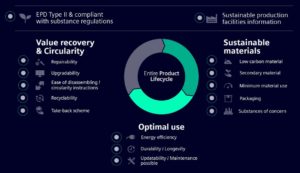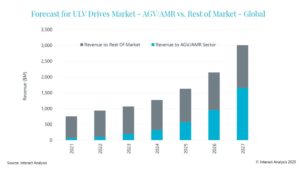ABB Delivers Strong Order Growth in Q3
ABB’s focus on profitable organic growth and the related strategic initiatives resulted in a strong order increase across all regions in the third quarter.
Total orders rose to $11.2 billion, boosted by large orders (above $15 million) including a power transmission link in Europe, a mining automation project in the Americas and a gas treatment plant in Africa. Base orders (below $15 million) increased in every region. Continued successful implementation of ABB’s service strategy resulted in a 10 percent increase in service orders in the quarter.
“Our program for profitable organic growth has successfully created healthy order momentum across all regions,” said CEO Ulrich Spiesshofer. “I am encouraged to see attractive large project wins and five consecutive quarters of base order growth.”
In line with a lower order backlog at the start of 2014, revenues were 6 percent lower (4 percent like-forlike) at $9.8 billion. The operational EBITDA margin was 14.3 percent in the third quarter versus 15.7 percent a year earlier. The margin reflected lower revenues and the result in Power Systems (PS).
“In PS, we achieved significant milestones in project execution, continued to de-risk the portfolio and implement a new business model for offshore wind projects,” Spiesshofer said. “The division broke even in the quarter. We continue to drive our focused action program to complete the turnaround and address the remaining challenges ahead. Overall, our efforts on relentless execution, including our cost savings program, are on track.”
Net income was $734 million and basic earnings per share was $0.32. Targeted net working capital management measures supported cash from operations, which increased 29 percent in the first nine months. ABB initiated the $4 billion share buyback program announced in September and purchased shares with a value of approximately $350 million during the quarter.
“We are driving profitable growth through penetration, innovation and expansion, aimed at growing ahead of the global economy.” the CEO added. “We will carefully manage costs and cash as the short-term outlook for the global economy is increasingly uncertain. The entire management team is taking decisive actions in line with our Next Level strategy, which was announced at our Capital Markets Day in September.”
Summary of Q3 results
Growth overview
Utility demand for power distribution solutions was steady in the quarter while investments in power transmission systems remained selective. Industrial demand varied by region and end market, with positive demand in oil and gas and general industry. Demand in the mining sector was stable at low levels. Infrastructure and construction markets were mixed, while rail and marine transportation demand was positive.
In this mixed environment, total orders received were up 25 percent in the quarter (28 percent on a likefor-like basis). Most of the increase resulted from higher large orders, which represented 25 percent of total orders received in the quarter, compared to 9 percent in the same quarter in 2013.
Base orders were up 3 percent (5 percent like-for-like) on a combination of growing demand in some of ABB’s early-cycle product businesses—such as wiring accessories and low-voltage motors—as well as growth initiatives across many businesses, products and geographies. Base order growth was strongest in the Discrete Automation and Motion division and in the two power divisions.
Service orders increased 10 percent and represented 15 percent of total orders, down from the year-earlier quarter due to the effects of the higher total order intake.
Revenues declined in the third quarter (down 4 percent like-for-like). Higher like-for-like revenues in the Discrete Automation and Motion and Low Voltage Products divisions were more than offset by a decline in the Process Automation, Power Products and Power Systems divisions, where opening order backlogs were lower. Service revenues were steady and reached 16 percent of total revenues, up from 15 percent in the same quarter a year earlier.
The order backlog at the end of September amounted to $27 billion, an increase of 4 percent compared to the end of the same quarter in 2013 and 9 percent higher than at the end of 2013.
All regions recorded growth in base and large orders on a like-for-like basis and across both power and automation in the third quarter.
Growth in Europe was led by the UK, where both large and base orders increased strongly. Switzerland, Finland and France also showed strong order growth, while Germany was lower. Order growth in the Americas mainly reflects a large mining order in Brazil. Orders in the US grew on a like-for-like basis. Large marine orders in South Korea led strong Asia growth in the quarter. This was supported by continued growth in China, although at a slower pace than in the first half of the year. Orders decreased in India.
Orders increased in the Middle East and Africa, led by the large order won in Tunisia, and were higher in both power and automation.
Orders received and revenues by division
Discrete Automation and Motion: Orders increased in all businesses and regions, driven by growth initiatives to drive base orders—including service—as well as continued demand growth in sectors such as rail and marine. Higher revenues were driven mainly by the execution of the strong order backlog in robotics as well as power conversion and service.
Low Voltage Products: Like-for-like orders increased in a mixed environment, and were steady to higher in all businesses. Regionally, growth was driven by Asia, the Americas and the Middle East and Africa. Europe orders were steady. Like-for-like revenues grew in line with orders.
Process Automation: Large orders in the oil and gas, marine and mining sectors offset a decline in base orders in the quarter. Orders grew strongly in all regions. Revenues decreased, reflecting the lower opening order backlog. An increase in lifecycle service revenues in the quarter was offset by lower full service revenues.
Power Products: Large and base orders increased in most markets supported by the industry sector and continued selective investments in large transmission projects. Orders grew at a double-digit pace in Europe, the Americas and the Middle East and Africa. Orders were lower in Asia but grew in China. The revenue decline in the quarter mainly reflects the lower opening order backlog.
Power Systems: Higher orders in the quarter reflect an increase in both base and large orders, including an $800-million order for an HVDC (high-voltage direct current) connection in the UK. Initiatives to drive base order growth contributed to a double-digit base order increase. Utilities remained cautious in their power transmission investments and ABB continues to be selective, focusing on margin and pull-through. Revenues were lower than the previous year, impacted by the lower opening order backlog and the execution delays in selected projects.
Earnings overview
Operational EBITDAOperational EBITDA in the third quarter of 2014 amounted to $1.4 billion, 13 percent below the year-earlier period. The operational EBITDA margin also declined. These results were due primarily to lower revenues and the ongoing execution of certain low- and negative-margin projects out of the backlog in Power Systems. Cost savings and further productivity improvements more than offset price pressures in the quarter.
Net income
Net income for the quarter amounted to $734 million. After-tax gains from the sale of businesses amounted to $145 million in the quarter. Net income for the quarter also included net pre-tax charges for foreign exchange and commodity timing differences of $76 million compared with positive pre-tax impacts of $113 million in the third quarter of 2013. Basic earnings per share amounted to $0.32 in the third quarter compared to $0.36 in the same quarter a year earlier.
Earnings and cash flows by division
Discrete Automation and Motion: The operational EBITDA margin decline reflects the dilutive impact from Power-One, acquired during the third quarter of 2013. Excluding that impact, the division’s operational EBITDA margin was higher versus the year-earlier period.
Low Voltage Products: The operational EBITDA margin decline mainly reflects a higher share of system revenues, which tend to have lower margins.
Process Automation: The operational EBITDA and margin decline mainly reflects the impact of lower revenues and the comparison with a very strong result in the same quarter a year earlier.
Power Products: Cost savings and favorable mix secured margin stability despite lower revenues.
Power Systems: The low operational EBITDA and margin mainly reflect the continued impact of projectrelated costs in offshore wind and engineering, procurement and construction (EPC) contracts in solar power generation. Lower revenues also affected earnings.
Balance sheet and cash flow
Total debt at the end of the third quarter amounted to around $7.9 billion, approximately the same as at the end of 2013. Net debt at the end of the third quarter increased slightly compared to the end of 2013 and amounted to approximately $1.7 billion. ABB reported cash from operations of $1.2 billion in the third quarter, a decrease of 6 percent compared with the third quarter in 2013. For the first nine months of 2014, cash from operations increased 29 percent as the impacts from an improvement in net working capital (NWC) more than offset the impacts of lower net income during the period. NWC as a percentage of revenues4 amounted to 16.6 percent compared with 17.8 percent in the third quarter of 2013.
Share buyback
As announced at its Capital Markets Day on September 9, ABB has initiated a $4-billion share buyback program. During September, ABB purchased approximately 15.4 million shares under the program with a buyback value of approximately $350 million.
Divestitures
ABB completed the previously-announced divestiture of Thomas & Betts’ steel structures business during the third quarter for cash proceeds of approximately $590 million. The company also announced in August an agreement to divest its Full Service business for an undisclosed amount. The sale is expected to close in the fourth quarter of 2014, subject to regulatory approval.
Next Level strategy
In September, ABB announced its Next Level strategy and financial targets for the 2015-2020 period aimed at accelerating sustainable value creation. The strategy builds on ABB’s three focus areas of profitable growth, relentless execution and business-led collaboration. The company intends to drive profitable growth by shifting its center of gravity toward high-growth end markets, enhancing competitiveness and lowering risk in business models. Under the plan, ABB expects to grow operational earnings per share (EPS) 10-15 percent compound annual growth rate (CAGR) and deliver attractive cash returns on investment (CROI) in the mid-teens over the period 2015-2020. It targets to grow revenues on a like-for-like basis on average 4-7 percent per year, faster than forecasted GDP and market growth. ABB plans to steadily increase over the same time period its profitability, measured in operational EBITA, within a bandwidth of 11-16 percent while targeting an average conversion of the annual free cash flow above 90 percent. The new financial targets take effect on January 1, 2015.
Management changes
In connection with the Next Level strategy announced in September, the company said it is aligning its Executive Committee (EC) structure. Peter Terwiesch, currently head of ABB in Central Europe and Germany, was appointed EC member responsible for the Process Automation division. ABB also said it will streamline its regional structure from eight to three regions responsible for customer collaboration, shared services and the related countries. The newly created regions will be led by current EC members – Frank Duggan (Asia, Middle East and Africa), Greg Scheu (Americas) and Veli-Matti Reinikkala (Europe). All organizational and management changes are effective January 1, 2015.
Outlook
The long-term demand outlook for ABB’s businesses remains clearly positive. The need for efficient and reliable electricity transmission and distribution will continue to increase, driven by factors such as: accelerating urbanization in emerging markets; actions to address global warming; the rapidly increasing power needs from digitization; and the refurbishment of aging power grids. At the same time, demand for industrial automation solutions will grow as customers strive to improve productivity, efficiency, product quality, and safety. These trends are also expected to drive demand in ABB’s infrastructure and transportation markets. ABB is well positioned to tap these opportunities for long-term profitable growth with its strong market presence, broad geographic and business scope, technology leadership and financial strength.
In the short term, macroeconomic and geopolitical developments are signaling a mixed picture with increased uncertainty. Some early-cycle macroeconomic signs in the US remain positive and growth in China is expected to continue. At the same time, the market remains impacted by slow growth in Europe, political tensions in various parts of the world as well as the health situation in Africa.
In this market environment, ABB’s management team aims to continue to outgrow its market in major customer segments by systematically driving profitable organic growth through increased market penetration, generating more revenues from our pipeline of new product innovations, and expanding into new attractive market segments. In addition, management intends to accelerate business-led collaboration, such as further developing the service business, driving the successful integration of acquired businesses and increasing ABB’s productivity by focusing stronger on the needs of customers. A third priority is relentless execution, especially in the areas of cost savings, cash flow generation and returning the Power Systems division to higher and more consistent returns.
Source: ABB Group







